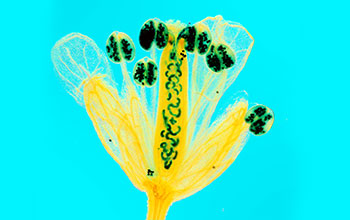Multimedia Gallery
"Self-fertilization"
"Self-fertilization," by Heiti Paves, Tallinn University of Technology, Estonia.
Within its tiny, white flowers, thale cress (Arabidopsis thaliana) does what most plants avoid--it fertilizes itself. Paves took this photograph of the flower with its pollen grains and ovaries stained blue to show the process in action. From the six pollen heads, the grains grow thin tubes toward the bean-shaped ovaries in the flower's stigma to fertilize them. Because of the microscope technique used, polarized light turns the normally white flower yellow and the background blue. Scientists have used A. thaliana in many genetic studies because its self-fertilization makes experiments clearer. Gregor Mendel, a 19th century priest and scientist, used the self-fertilizing pea plant to build his genetic theories, Paves notes.
This image won Honorable Mention in the Photography category of the 2009 International Science & Engineering Visualization Challenge (SciVis) competition, sponsored by the National Science Foundation and the journal Science. The competition is held each year to celebrate the grand tradition of science visualization and to encourage its continued growth. The spirit of the competition is to communicate science, engineering and technology for education and journalistic purposes. To learn more about the competition and view all the winning entries, see the NSF SciVis Special Report. (Date of Image: 2006)
Credit: Heiti Paves and Birger Ilau, Tallinn University of Technology
Images and other media in the National Science Foundation Multimedia Gallery are available for use in print and electronic material by NSF employees, members of the media, university staff, teachers and the general public. All media in the gallery are intended for personal, educational and nonprofit/non-commercial use only.
Images credited to the National Science Foundation, a federal agency, are in the public domain. The images were created by employees of the United States Government as part of their official duties or prepared by contractors as "works for hire" for NSF. You may freely use NSF-credited images and, at your discretion, credit NSF with a "Courtesy: National Science Foundation" notation.
Additional information about general usage can be found in Conditions.
Also Available:
Download the high-resolution TIF version of the image. (9.6 MB)
Use your mouse to right-click (Mac users may need to Ctrl-click) the link above and choose the option that will save the file or target to your computer.



